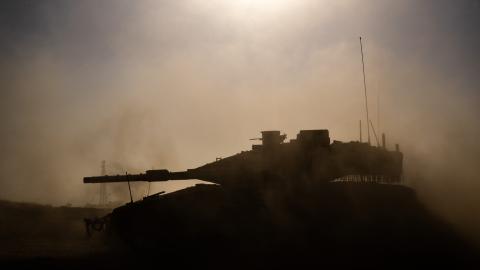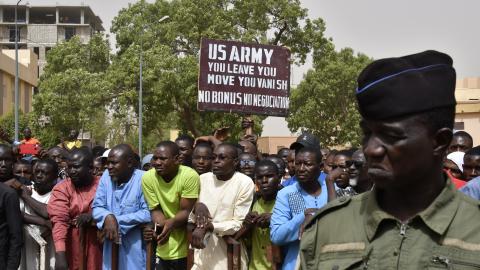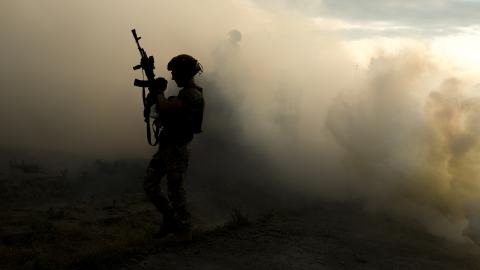This report first appeared as a part of Hudson's Re: Ukraine newsletter series. To subscribe, click here.
Below Hudson Senior Fellow Can Kasapoğlu offers a military situational report about the war in Ukraine.
1. Pro-Kyiv Chechen Fighters Raid Russian Supply Convoy Near Belgorod
This week Ukraine’s Main Directorate of Intelligence (GUR) released a Telegram upload that showed an assault on Russian logistics convoys by battle-hardened Chechen fighters of the newly formed Ichkerian Department of Military Intelligence. This incident is important for two reasons.
First, it indicates that the Ukrainian military is keen to increase the pressure on the Russian frontier. The assault was a cross-border raid near Russia’s troubled Belgorod region. Belgorod has long witnessed the anti-Kremlin activities of Russian paramilitary groups, the Freedom of Russia Legion, and the Russian Volunteer Corps. Paramilitary activities in Belgorod have become so pronounced that Russia has sent a high-rank commander, General Aleksandr Lapin, to oversee a counterinsurgency campaign there. This week’s assault shows that Belgorod will likely remain a flashpoint on the Russian border.
Second, the incident carries deep implications for inter-Chechen machinations playing out on the battlefield. The Telegram post reportedly shows an important Chechen figure, Abdul Hakim al-Shishani, operating with his network of fighters in combat operations with the Ukrainian military. Al-Shishani has been a key figure in efforts by Akhmat Zakaev, the prime minister of the Chechen Republic of Ichkeria’s government-in-exile, to gather all anti-Moscow Chechen battalions under a unified command in Ukraine. Zakaev, a veteran Chechen politician with roots in General Dzhokhar Dudaev’s independence movement of the 1990s, aims to use the Russia-Ukraine War to advance his cause in the Caucasus. The Ichkerian detachments’ operations in the Russian Federation mark a milestone in the Chechen dimension of the current conflict.
On the other side of the trenches, pro-Moscow Chechen strongman Ramzan Kadyrov is also looking out for his own interests. Following Wagner’s withdrawal from operations in Ukraine, Kadyrov dispatched elite combat formations to hold the line in Bakhmut. Amidst the Wagner mutiny, Kadyrov’s fighters rushed to protect Moscow. After the mutiny had been quelled, Kadyrov met with Russian President Vladimir Putin in the Kremlin. Putin subsequently paid a visit to the Muslim-populated region of Dagestan to cement his grip on power there.
Hudson Institute’s Ukraine Military Situation Report has previously flagged Chechen intrigue playing out in Ukraine. Alongside the main conflict there, it is now evident that a Chechen civil war—between anti-Kadyrov and pro-Kadyrov factions—is playing out on Ukrainian soil. This week’s developments mark a new stage of escalation in that fight.
2. Developments in Belarus Portend Trouble
In line with previous Hudson assessments, the Wagner Group, Yevgeny Prigozhin’s shadow army akin to a Russian version of Hezbollah, lives on.
Open-source tracking of Wagner columns on Belarusian territory suggests that thousands of Wagner fighters have been pouring into that country this week. With Wagner beginning to train the Belarusian military, Prigozhin’s role in Belarus has also begun to take shape. For some time the regime of Belarusian strongman Alexander Lukashenko has been wanting a countrywide paramilitary network of “people’s militia.” It seems Wagner will help create it.
This is just one development of many that suggests the West should keep an eye on Belarus, lest it become the North Korea of Europe. Minsk has already been making serious investments in its military capabilities through generous arms procurements from Russia, especially of the S-400 long-range surface-to-air missile (SAM) system and the SS-26 Iskander-M ballistic missile system, a dual-capable weapon certified for nuclear delivery.
These systems could threaten NATO’s military presence on the alliance’s eastern front. According to Russian news stories, the Belarusian Iskander missiles have been trained to conduct nuclear tasks. Together with the Su-24 frontline bomber and the Su-25 attack aircraft, the Iskander-M tactical ballistic missiles form Russia’s forward-deployed tactical nuclear deterrent in Belarus. Since the outset of the invasion of Ukraine, Belarus has also been hosting Russian Mig-31K interceptor aircraft carrying nuclear-capable Kinzhal hypersonic missiles, in essence the aeroballistic variant of the Iskander baseline. To date, Russian Aerospace Forces have not hesitated to unleash Kinzhal missiles in attacks on Ukraine’s critical infrastructure and population centers.
Apart from strategic weapons, the Belarusian Armed Forces will operate new Russian arms in conventional settings, including Mi-35M multirole combat helicopters and TOR-M2 air defenses. Minsk will also place additional orders for the Su-30SM fighters. This demonstrates a growing trend toward integration between the Russian and Belarusian armed forces.
Lukashenko’s rhetoric reflects Belarus’s recent military activity. In March 2023, in his annual address to the nation, Lukashenko lamented that Poland’s defense modernization plans and NATO’s open-door policy make cooperation with the Kremlin his best choice. It seems he has accepted his country’s role as Russia’s satellite garrison state in Europe.
As NATO’s recent Vilnius Summit Communiqué emphasized, Wagner’s presence in Belarus has become a security challenge for Europe, particularly as it impacts Poland’s national defense plans. Wagner’s continuing work on Belarusian territory, as well as the presence of Russia’s nuclear weapons there, will only amplify that threat in the coming months.
3. Naval Drones Pound the Kerch Bridge
On July 17, unmanned surface drones attacked the Kerch Bridge, a vital chokepoint connecting occupied Crimea to Russia. News stories suggest that the Ukrainian Security Service (SBU) conducted the assault in cooperation with the Ukrainian Navy. This marks the second robotic naval warfare assault that Ukraine has recently carried out in the Black Sea—the first, on July 16, targeted Russia’s Sevastopol Base in Crimea. Open-source intelligence suggests that Russian defenses managed to thwart that strike. The July 17 attack therefore marks the successful consummation of a broader Ukrainian plan. The Russian Foreign Office confirmed the strike.
Shortly thereafter, Moscow signaled its withdrawal from the Turkish-brokered grain deal enabling Ukraine to maintain its food exports, a critical arrangement under United Nations supervision to keep the global food supply flowing smoothly amidst the war. It remains to be seen if the Kremlin will return to the deal, as it did in October 2022, or if Russia will opt to escalate in the Black Sea. In the meantime, Hudson Institute will continue to monitor increased Russian missile and drone salvos pounding the Ukrainian coastal city of Odesa.
Since October 2022, Ukraine has effectively employed unmanned surface vehicles in the Black Sea, posing an asymmetric threat to the Russian Black Sea Fleet. Limited wreckage data and visual evidence suggest that the Ukrainian security services destroy their targets using fast naval kamikaze drones carrying explosive warheads. These inexpensive but effective assets equip Ukraine with a smart advantage against the Russian naval presence.
4. Russia Concentrates Its Forces in Kupyansk for Likely Offensive Action
Ukrainian Deputy Defense Minister Hanna Maliar confirmed that the Russian military has been amassing combat formations in the Donbas region to conduct an offensive push along the Kupyansk axis. Such an assault would pressure Ukrainian units in Kharkiv, possibly forcing the Ukrainian General Staff to reallocate reserves from the main counteroffensive effort in the south of the country. Ukrainian sources report a large Russian troop presence in the Donbas, comprising some 100,000 personnel and 900 platforms of heavy armor, augmented by hundreds of artillery pieces and multiple-launch rocket systems.
In the age of drones, social media data harvesting, and commercially available satellite imagery intelligence, it is almost impossible to conceal such a massive mobilization from the eyes of open-source intelligence professionals. Yet the size of the mobilization does not necessarily spell doom for Ukraine. A substantial portion of the reported troop buildup is likely composed of newly established Storm-Z troops, most of whom are undertrained reservists and mobilized convicts. In addition, force-to-force and force-to-terrain ratios, as well as unquantifiable variables such as the morale, training, and warfighting capabilities of troops, have the potential to tip the scales in any given battle. So while the Russian buildup is alarming, it would be premature for Ukrainian forces to beat to quarters.
Nonetheless, considering the present battlefield geometry of the war, limited Russian offensive action in the east remains within the realm of possibility, if only to distract Ukrainian forces from their main effort in the south.












